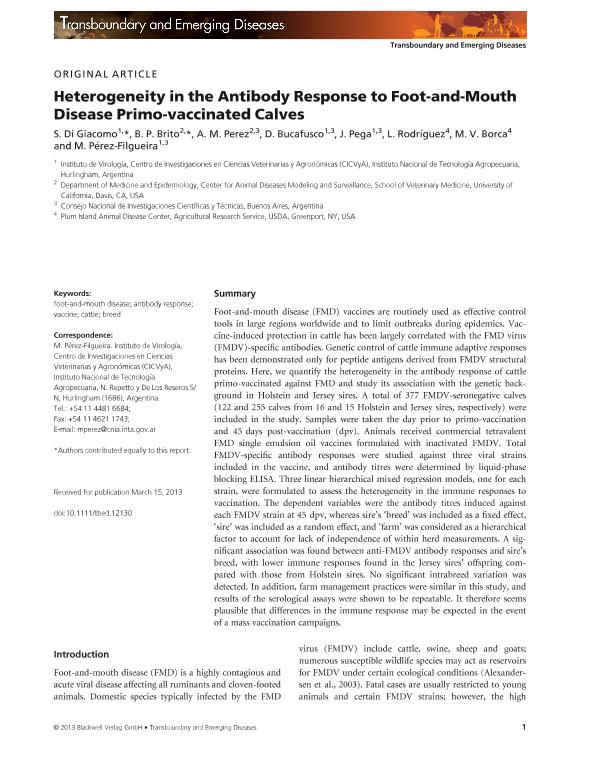Mostrar el registro sencillo del ítem
dc.contributor.author
Di Giacomo, Sebastián Víctor

dc.contributor.author
Brito, Bárbara
dc.contributor.author
Perez, Andres Maximiliano

dc.contributor.author
Bucafusco, Danilo

dc.contributor.author
Pega, Juan Franco

dc.contributor.author
Rodríguez, Luis
dc.contributor.author
Borca, Manuel Víctor
dc.contributor.author
Pérez Filgueira, Daniel Mariano

dc.date.available
2020-05-07T13:43:44Z
dc.date.issued
2013-07
dc.identifier.citation
Di Giacomo, Sebastián Víctor; Brito, Bárbara; Perez, Andres Maximiliano; Bucafusco, Danilo; Pega, Juan Franco; et al.; Heterogeneity in the antibody response to foot-and-mouth disease primo vaccinated calves; Wiley Blackwell Publishing, Inc; Transboundary And Emerging Diseases; 2013; 7-2013; 1-10
dc.identifier.issn
1865-1674
dc.identifier.uri
http://hdl.handle.net/11336/104470
dc.description.abstract
Foot-and-mouth disease (FMD) vaccines are routinely used as effective control tools in large regions worldwide and to limit outbreaks during epidemics. Vaccine-induced protection in cattle has been largely correlated to the FMD virus (FMDV)-specific antibodies. Genetic control of cattle immune adaptive responses has been demonstrated only for peptide antigens derived from FMDV structural proteins. Here, we quantify the heterogeneity in the antibody response of cattle primo-vaccinated against FMD and study its association with the genetic background in Holstein and Jersey sires. A total of 377 FMDV seronegative calves (122 and 255calves from 16 and 15 Holstein and Jersey sires, respectively) were included in the study. Samples were taken the day prior to primovaccination and 45 days post-vaccination (dpv). Animals received commercial tetravalent FMD single-emulsion oil vaccines formulated with inactivated FMDV. Total FMDVspecific antibody responses were studied against 3 viral strains included in the vaccine and antibody titers were determined by liquid phase blocking-ELISA. Three linear hierarchical mixed regression models, one for each strain, were formulated to assess the heterogeneity in the immune responses to vaccination. The dependent variables were the antibody titers induced against each FMDV strain at 45 dpv, whereas sire?s ?breed? was included as a fixed effect, ?sire? was included as a random effect and ?farm? was considered as a hierarchical factor to account for lack of independence of within herd measurements. A significant association was found between anti-FMDV antibody responses and sire?s breed, with lower immune responses found in the Jersey sires? offspring compared to those from Holstein sires. No significant intra-breed variation was detected. In addition, farm management practices were similar in this study and results of the serological assays were shown to be repeatable. It therefore seems plausible that differences in the immune response may be expected in the event of a mass vaccination campaigns.
dc.format
application/pdf
dc.language.iso
eng
dc.publisher
Wiley Blackwell Publishing, Inc

dc.rights
info:eu-repo/semantics/openAccess
dc.rights.uri
https://creativecommons.org/licenses/by-nc-sa/2.5/ar/
dc.subject
FMDV
dc.subject
ANTIBODY RESPONSE
dc.subject
VACCINE
dc.subject
CATTLE
dc.subject
BREED
dc.subject.classification
Ciencias Veterinarias

dc.subject.classification
Ciencias Veterinarias

dc.subject.classification
CIENCIAS AGRÍCOLAS

dc.subject.classification
Inmunología

dc.subject.classification
Medicina Básica

dc.subject.classification
CIENCIAS MÉDICAS Y DE LA SALUD

dc.title
Heterogeneity in the antibody response to foot-and-mouth disease primo vaccinated calves
dc.type
info:eu-repo/semantics/article
dc.type
info:ar-repo/semantics/artículo
dc.type
info:eu-repo/semantics/publishedVersion
dc.date.updated
2020-04-28T14:09:15Z
dc.journal.volume
2013
dc.journal.pagination
1-10
dc.journal.pais
Reino Unido

dc.journal.ciudad
Londres
dc.description.fil
Fil: Di Giacomo, Sebastián Víctor. Instituto Nacional de Tecnología Agropecuaria. Centro de Investigación en Ciencias Veterinarias y Agronómicas. Instituto de Virología; Argentina
dc.description.fil
Fil: Brito, Bárbara. University of California; Estados Unidos
dc.description.fil
Fil: Perez, Andres Maximiliano. University of California; Estados Unidos. Consejo Nacional de Investigaciones Científicas y Técnicas; Argentina
dc.description.fil
Fil: Bucafusco, Danilo. Consejo Nacional de Investigaciones Científicas y Técnicas; Argentina. Instituto Nacional de Tecnología Agropecuaria. Centro de Investigación en Ciencias Veterinarias y Agronómicas. Instituto de Virología; Argentina
dc.description.fil
Fil: Pega, Juan Franco. Instituto Nacional de Tecnología Agropecuaria. Centro de Investigación en Ciencias Veterinarias y Agronómicas. Instituto de Virología; Argentina. Consejo Nacional de Investigaciones Científicas y Técnicas; Argentina
dc.description.fil
Fil: Rodríguez, Luis. United States Department of Agriculture. Agricultural Research Service; Argentina
dc.description.fil
Fil: Borca, Manuel Víctor. United States Department of Agriculture. Agricultural Research Service; Argentina
dc.description.fil
Fil: Pérez Filgueira, Daniel Mariano. Consejo Nacional de Investigaciones Científicas y Técnicas; Argentina. Instituto Nacional de Tecnología Agropecuaria. Centro de Investigación en Ciencias Veterinarias y Agronómicas. Instituto de Virología; Argentina
dc.journal.title
Transboundary And Emerging Diseases

dc.relation.alternativeid
info:eu-repo/semantics/altIdentifier/url/http://onlinelibrary.wiley.com/doi/10.1111/tbed.12130/full
dc.relation.alternativeid
info:eu-repo/semantics/altIdentifier/doi/http://dx.doi.org/10.1111/tbed.12130
Archivos asociados
